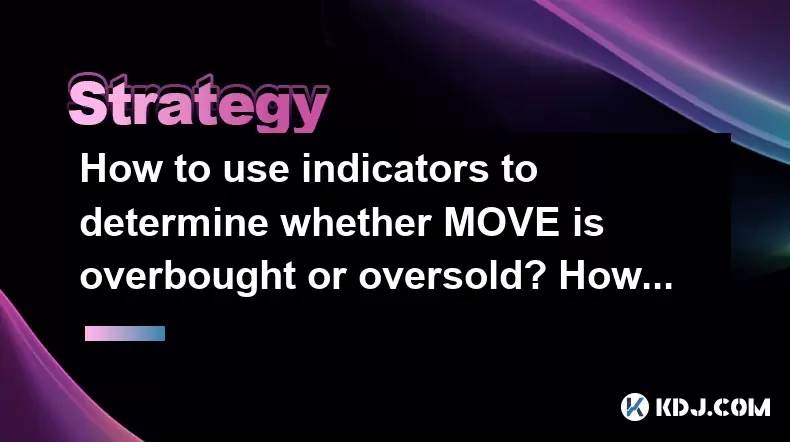-
 bitcoin
bitcoin $122025.899241 USD
-2.12% -
 ethereum
ethereum $4488.068729 USD
-4.11% -
 bnb
bnb $1315.348019 USD
8.65% -
 tether
tether $1.000457 USD
0.03% -
 xrp
xrp $2.875326 USD
-3.69% -
 solana
solana $222.043604 USD
-4.07% -
 usd-coin
usd-coin $0.999682 USD
0.00% -
 dogecoin
dogecoin $0.249887 USD
-5.62% -
 tron
tron $0.337379 USD
-2.59% -
 cardano
cardano $0.827763 USD
-5.06% -
 hyperliquid
hyperliquid $45.774531 USD
-2.43% -
 chainlink
chainlink $22.079309 USD
-5.87% -
 ethena-usde
ethena-usde $1.000156 USD
0.02% -
 sui
sui $3.482566 USD
-3.57% -
 stellar
stellar $0.386982 USD
-4.92%
How to use indicators to determine whether MOVE is overbought or oversold? How to use RSI and MACD?
Use RSI and MACD to determine if MOVE is overbought or oversold; RSI above 70 suggests overbought, below 30 indicates oversold, while MACD crossovers and divergences provide additional insights.
May 09, 2025 at 03:42 am

Understanding whether a cryptocurrency like MOVE is overbought or oversold is crucial for making informed trading decisions. Technical indicators such as the Relative Strength Index (RSI) and the Moving Average Convergence Divergence (MACD) are widely used tools that can help traders gauge the momentum and potential reversal points of a cryptocurrency. This article will delve into how to use these indicators to determine if MOVE is overbought or oversold, providing detailed steps and explanations.
Understanding Overbought and Oversold Conditions
Overbought conditions occur when an asset's price has risen too quickly and may be due for a correction. Conversely, oversold conditions indicate that an asset's price has fallen too rapidly and might be poised for a rebound. Both scenarios suggest potential trading opportunities, but it's essential to use reliable indicators to confirm these conditions.
Using the Relative Strength Index (RSI)
The RSI is a momentum oscillator that measures the speed and change of price movements. It ranges from 0 to 100 and is typically used to identify overbought or oversold conditions.
How to Calculate RSI
To calculate the RSI, you need to follow these steps:
- Calculate the average gain and average loss over a specified period, usually 14 days.
- Compute the relative strength (RS) by dividing the average gain by the average loss.
- Calculate the RSI using the formula: RSI = 100 - (100 / (1 + RS)).
Interpreting RSI for MOVE
- An RSI value above 70 typically indicates that MOVE is overbought. This suggests that the price may have risen too far, too fast, and a price correction could be imminent.
- An RSI value below 30 suggests that MOVE is oversold. This indicates that the price may have fallen too far, too fast, and a price rebound could be on the horizon.
Practical Application of RSI
To use RSI effectively for MOVE, follow these steps:
- Access a charting platform that supports RSI, such as TradingView or Coinigy.
- Add the RSI indicator to the MOVE chart, setting the period to 14 days.
- Monitor the RSI values over time. If the RSI consistently stays above 70, it might be a signal to consider selling or shorting MOVE. If it stays below 30, it might be a signal to consider buying or going long.
Using the Moving Average Convergence Divergence (MACD)
The MACD is another popular momentum indicator that helps traders identify potential trend reversals and momentum shifts. It consists of two lines: the MACD line and the signal line.
How to Calculate MACD
To calculate the MACD, follow these steps:
- Calculate the 12-day and 26-day exponential moving averages (EMAs) of MOVE's price.
- Subtract the 26-day EMA from the 12-day EMA to get the MACD line.
- Calculate the 9-day EMA of the MACD line to get the signal line.
Interpreting MACD for MOVE
- A bullish crossover occurs when the MACD line crosses above the signal line, suggesting that MOVE's momentum is increasing and it might be a good time to buy.
- A bearish crossover happens when the MACD line crosses below the signal line, indicating that MOVE's momentum is decreasing and it might be a good time to sell.
- Divergence between the MACD and MOVE's price can also signal potential reversals. If MOVE's price is making new highs while the MACD is not, it could indicate an overbought condition. Conversely, if MOVE's price is making new lows while the MACD is not, it could indicate an oversold condition.
Practical Application of MACD
To use MACD effectively for MOVE, follow these steps:
- Access a charting platform that supports MACD, such as TradingView or Coinigy.
- Add the MACD indicator to the MOVE chart, setting the parameters to 12, 26, and 9.
- Monitor the MACD and signal lines for crossovers and divergences. If you see a bullish crossover, it might be a signal to consider buying MOVE. If you see a bearish crossover, it might be a signal to consider selling MOVE.
Combining RSI and MACD for MOVE
Using both RSI and MACD together can provide a more comprehensive view of MOVE's market conditions. Here's how to combine them effectively:
- Look for confirmation between the two indicators. If RSI indicates that MOVE is overbought (above 70) and the MACD shows a bearish crossover, it strengthens the case for a potential price correction.
- Watch for divergence between the indicators and MOVE's price. If RSI is showing an oversold condition (below 30) and the MACD is showing a bullish divergence, it could signal a strong buying opportunity.
Practical Example: Analyzing MOVE with RSI and MACD
Let's walk through a hypothetical example of how to use RSI and MACD to analyze MOVE:
- Step 1: Open a charting platform and load the MOVE chart.
- Step 2: Add the RSI indicator with a 14-day period and the MACD indicator with parameters 12, 26, and 9.
- Step 3: Observe the current RSI value. If it's above 70, MOVE might be overbought. If it's below 30, MOVE might be oversold.
- Step 4: Check the MACD for crossovers. A bullish crossover could confirm a buying opportunity if RSI is oversold, while a bearish crossover could confirm a selling opportunity if RSI is overbought.
- Step 5: Look for divergences between the indicators and MOVE's price. If RSI is showing an oversold condition and the MACD is showing a bullish divergence, it could be a strong signal to buy MOVE.
Frequently Asked Questions
Q1: Can RSI and MACD be used for other cryptocurrencies besides MOVE?Yes, RSI and MACD are versatile indicators that can be applied to any cryptocurrency. The principles of overbought and oversold conditions, as well as crossovers and divergences, remain the same across different assets.
Q2: How often should I check the RSI and MACD indicators for MOVE?It's advisable to check these indicators daily or at least weekly, depending on your trading strategy. For short-term traders, more frequent checks might be necessary, while long-term investors might find weekly checks sufficient.
Q3: Are there any other indicators I should use in conjunction with RSI and MACD for MOVE?Yes, other indicators like the Bollinger Bands, Stochastic Oscillator, and Volume Weighted Average Price (VWAP) can complement RSI and MACD. Each provides additional insights into MOVE's price movements and can help confirm signals from RSI and MACD.
Q4: Can RSI and MACD be used for predicting long-term trends in MOVE?While RSI and MACD are primarily used for short to medium-term trading signals, they can also provide insights into longer-term trends when combined with other technical analysis tools. However, for long-term predictions, fundamental analysis and broader market trends should also be considered.
Disclaimer:info@kdj.com
The information provided is not trading advice. kdj.com does not assume any responsibility for any investments made based on the information provided in this article. Cryptocurrencies are highly volatile and it is highly recommended that you invest with caution after thorough research!
If you believe that the content used on this website infringes your copyright, please contact us immediately (info@kdj.com) and we will delete it promptly.
- BlockDAG, DOGE, HYPE Sponsorship: Crypto Trends Shaping 2025
- 2025-10-01 00:25:13
- Deutsche Börse and Circle: A StableCoin Adoption Powerhouse in Europe
- 2025-10-01 00:25:13
- BlockDAG's Presale Buzz: Is It the Crypto to Watch in October 2025?
- 2025-10-01 00:30:13
- Bitcoin, Crypto, and IQ: When Genius Meets Digital Gold?
- 2025-10-01 00:30:13
- Stablecoins, American Innovation, and Wallet Tokens: The Next Frontier
- 2025-10-01 00:35:12
- NBU, Coins, and Crypto in Ukraine: A New Yorker's Take
- 2025-10-01 00:45:14
Related knowledge

Practical parameter settings for a Bitcoin multi-timeframe moving average system
Sep 18,2025 at 10:54pm
Optimizing Timeframe Combinations for Bitcoin Trading1. Selecting appropriate timeframes is crucial when building a multi-timeframe moving average sys...

How can I filter out false breakouts in Dogecoin high-frequency trading?
Sep 22,2025 at 01:00am
Understanding False Breakouts in Dogecoin Trading1. A false breakout occurs when Dogecoin's price appears to move beyond a defined support or resistan...

Techniques for identifying tops and bottoms in the Bitcoin on-chain NVT model
Sep 20,2025 at 07:54pm
Understanding the NVT Model in Bitcoin Analysis1. The Network Value to Transactions (NVT) ratio is often described as the 'P/E ratio' of the cryptocur...

What does the surge in open interest in Bitcoincoin futures mean?
Sep 20,2025 at 11:18pm
Understanding the Surge in Dogecoin Futures Open Interest1. A surge in open interest within Dogecoin futures indicates a growing number of active cont...

How can I use the Ethereum USDT premium to gauge market sentiment?
Sep 18,2025 at 11:55pm
Understanding the Ethereum USDT Premium1. The Ethereum USDT premium refers to the price difference between USDT (Tether) traded on Ethereum-based plat...

What should I do if Ethereum staking yields decline?
Sep 20,2025 at 06:18am
Understanding the Causes Behind Declining Ethereum Staking Yields1. The Ethereum network transitioned to a proof-of-stake consensus mechanism with the...

Practical parameter settings for a Bitcoin multi-timeframe moving average system
Sep 18,2025 at 10:54pm
Optimizing Timeframe Combinations for Bitcoin Trading1. Selecting appropriate timeframes is crucial when building a multi-timeframe moving average sys...

How can I filter out false breakouts in Dogecoin high-frequency trading?
Sep 22,2025 at 01:00am
Understanding False Breakouts in Dogecoin Trading1. A false breakout occurs when Dogecoin's price appears to move beyond a defined support or resistan...

Techniques for identifying tops and bottoms in the Bitcoin on-chain NVT model
Sep 20,2025 at 07:54pm
Understanding the NVT Model in Bitcoin Analysis1. The Network Value to Transactions (NVT) ratio is often described as the 'P/E ratio' of the cryptocur...

What does the surge in open interest in Bitcoincoin futures mean?
Sep 20,2025 at 11:18pm
Understanding the Surge in Dogecoin Futures Open Interest1. A surge in open interest within Dogecoin futures indicates a growing number of active cont...

How can I use the Ethereum USDT premium to gauge market sentiment?
Sep 18,2025 at 11:55pm
Understanding the Ethereum USDT Premium1. The Ethereum USDT premium refers to the price difference between USDT (Tether) traded on Ethereum-based plat...

What should I do if Ethereum staking yields decline?
Sep 20,2025 at 06:18am
Understanding the Causes Behind Declining Ethereum Staking Yields1. The Ethereum network transitioned to a proof-of-stake consensus mechanism with the...
See all articles










































































